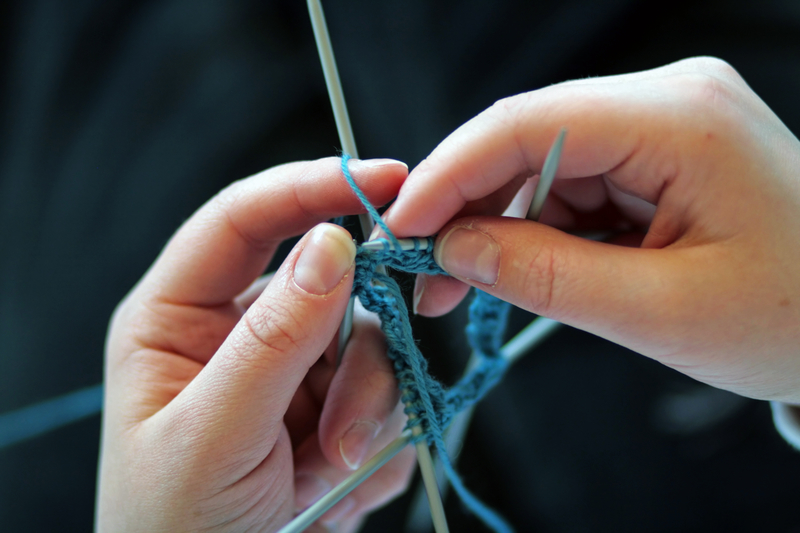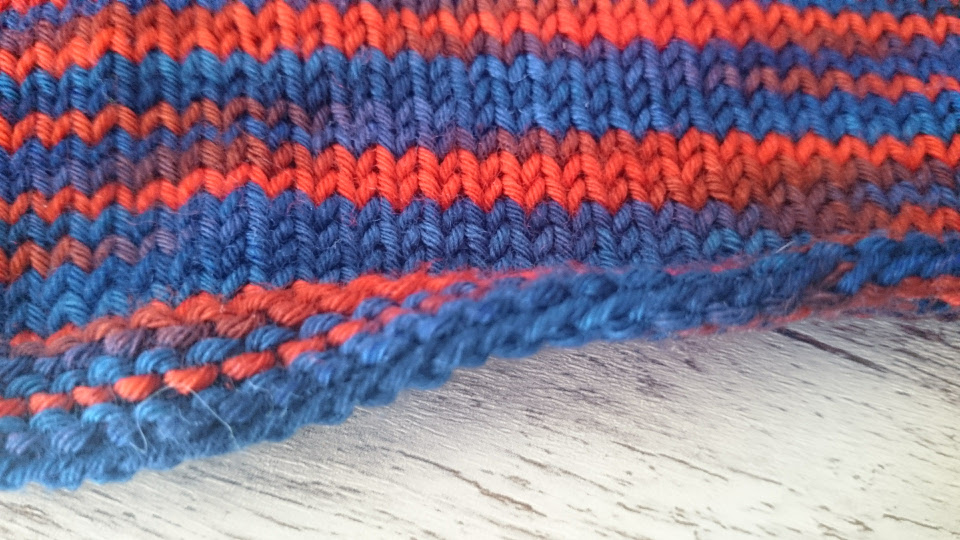I’ve recently been asked by a reader (hello Clelia!) how I avoid my stranded colorwork from puckering up in some places and being too loose with floppy floats in others. Those of you who have tried to knit colorwork before probably recognize those problems from their early attempts. Maybe even your only attempts. Maybe you decided that stranded colorwork just isn’t for you after your first failed endeavors? I assure you, we’ve all been there. I would show you my first colorwork tries – if I still had them.
But stranded colorwork is actually not that difficult to knit. As with most things, it all comes down to practice and finding what works well for you. Every knitter is different, knits differently or holds the yarn in a different way. Some knit tighter than another knitter might. Others knit looser. No one way is right or wrong or works for anyone.
There are a few things you can try out that have proven to work for a large number of knitters out there.
How to Hold the Yarn
First things first: I think it is important to hold both active strands of yarn at the same time. I know many knitters hold only one at a time and switch when the yarn needs to be switched. I see a few problems with that method, however.
- Reduced speed: Every time you need to switch colors you have to stop and pick up the other yarn. And suddenly something takes you four times as long to knit as it usually would.
- Tension: It can be tricky to get an even tension across your work this way because one strand is always dangling loosely in the back. Hats off to knitters who can keep good tension that way, I know I can’t. All that picking it back up, readjusting tension and knitting a few stitches and then switching again, makes my stitches uneven at best. And if I am not extremely careful, I may pull too tightly and get that beginners’ problem of the fabric puckering up in places. And I certainly can’t get my single-color stockinette fabric and my stranded colorwork fabric to have the same gauge.
Tensioning both strands at the same time is fiddly at first, but it doesn’t take too long to learn if you practice. There are two ways which I know that you can tension both active strands, and I use them both but for different kinds of colorwork.

Both strands held with my left index finger. I prefer this for double knitting, though.
For Pickers: Holding Both Yarns in Your Left Hand
I don’t actually know if it is possible to do this with your right hand. Andrea Lum seems to be tensioning both yarns well in this video, but I can’t make out how she’s doing it, and I can’t copy it either. If any of you lovely English knitters out there know, please leave an explanation in the comments. I would be interested to find out.
For you Continental Knitters it is relatively easy. You wrap one strand around your index finger with a forward loop (it looks a little like a yarn over) and the other strand the exact other around, back to front. They will overlap a bit. You hold them this way to keep the strands separate and have it easier to pick the correct yarn. The actual tensioning happens as usual between your fingers or in your hand where you will likely hold your strands together again (I do).
This is the method I use for double knitting when I switch colors after every stitch. It doesn’t work for me for most stranded colorwork because, after a few stitches, one strand will always end up looser than the other.
There are knitters who have both yarns wrapped the same way around the index fingers. I can’t knit at all that way; the strands would always slide together. But if it works for you, that’s great! As I’ve said before it is all about finding what works for you.
There are also some tools you can try out if you want and you find you can’t keep the yarn separated. They are called knitting thimbles or yarn guides. Here are a few I’ve seen:
I have tried the Clover yarn guide before but only for stranded knitting and since I can’t do stranded colorwork with both yarns in my left hand well, I haven’t used it in a while. I’ve meant to try it for double knitting, however. Just to see if that would make things smoother or not.
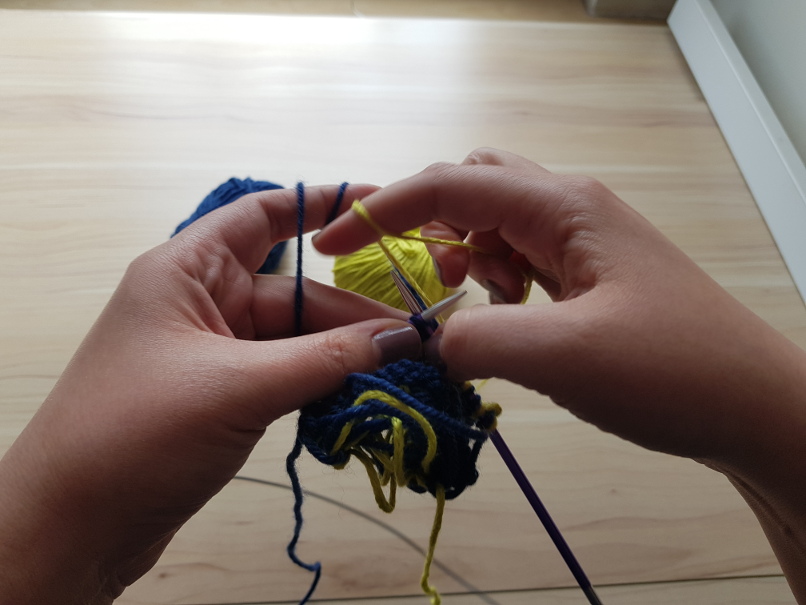
Knitting with the off-hand color. I had to include this beautiful in-action shot taken by Papa Wolf; I love how it turned out.
Holding One Strand with Each Hand
Now, this is my preferred method. And it is equally easy to learn for both English and Continental Knitters. Because you will be knitting both English and Continental style at the same time, both throwing and picking. (This is the same video with Andrea Lum as before. I would suggest watching the entire thing, it’s not long, and there is good information on yarn dominance and floats as well).
I learned this in a workshop years ago, and it has made my life so much easier. It’s quick and keeping an even tension is very easy. I also find that it makes my next bit of advice easier.
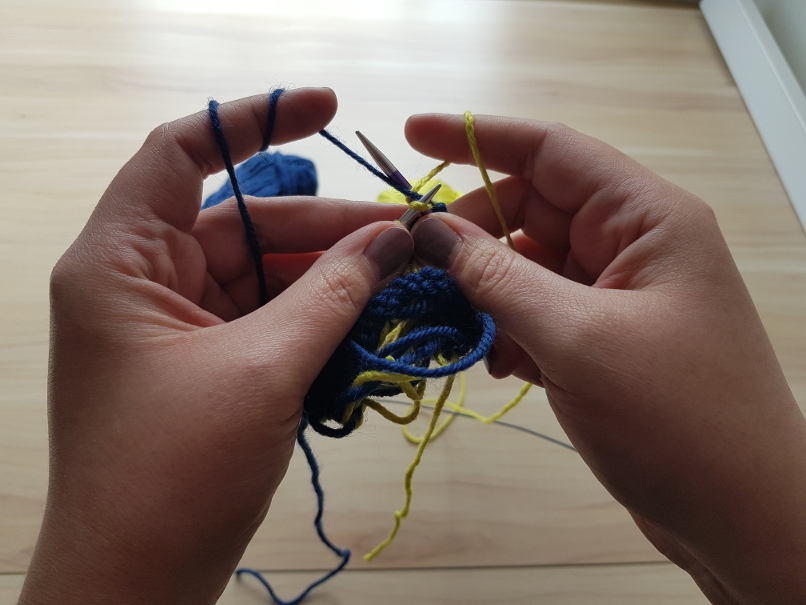
Catching a float with the yarn held in each hand.
Catching Floats
I catch my floats at about every fourth stitch with a single color. Even if I only knit five stitches with one color. That makes it easier for me to keep an even tension. I neither pull the yarn too tightly nor do I leave it hanging too loosely. It makes even the backside of the knitting look smooth and pretty, and you won’t have any large loops that you could get caught on.
I’ve learned this that the same workshop I mentioned above a few years, and it has made a huge difference for me.
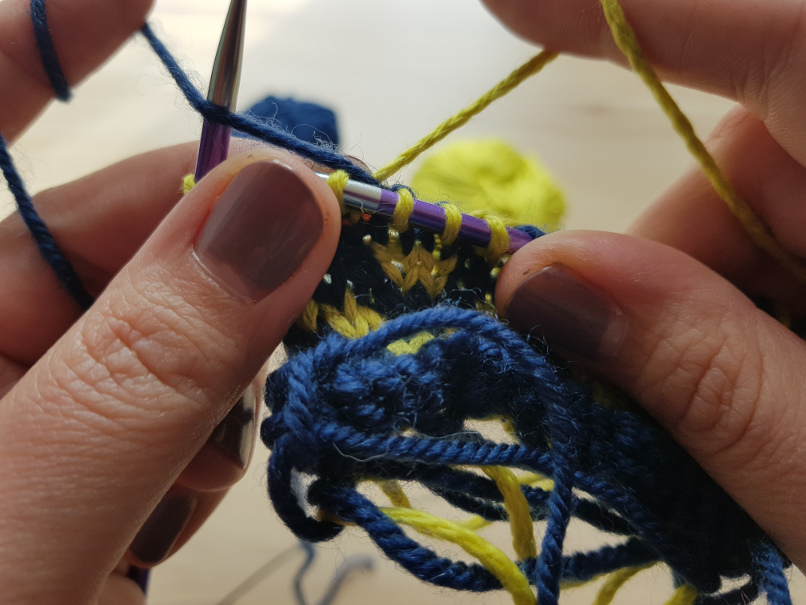
Spreading out the stitches
Spread out the Stitches
This is my last piece of advice. Every time I switch colors or catch a float I spread the stitches I just knit on my right-hand needle a bit. This way I have to leave enough yarn for the float and don’t end up pulling too tightly when I knit the next stitch.
This is especially important if you are also switching needles. I try to place a caught float as close to the end of a needle as possible, but you will still have to be careful to leave enough room for your fabric. We’ve been taught to pull the yarn tightly in between needles to avoid ladders. And that is still correct – for the yarn that is not “floating” in the back. Otherwise, you will get a pinching effect instead of the dreaded ladders. I’ve found I could avoid that by spreading the stitches out and knitting the stitch with the other yarn as I always would.
This is important for every first caught float or stitch with the other color on the new needle. Spread out the stitches and keep the floating yarn pressed along the fabric to give your stitches enough room.
Conclusion
These are the methods I use. I didn’t learn it overnight, and I had to practice, but it was well worth it. No more puckering, my knitting speed increased on colorwork, and even my gauge on colorwork and single color stockinette have become more similar as well. I hope you managed to find something useful in this. Something that might help you, should you be struggling with your colorwork.
For a closer look at some of the colorwork I’ve recently knit, check out my post on how to steek. There you can get a good look at my daughter’s Where the Wild Sheep Roam cardigan.
If you want more information: Craftsy has an excellent class on stranded colorwork that might be interesting for you: Stranded Colorwork: Basics and Beyond, with Sunne Meyer (*). It does not just show you in-depth how to catch floats in various knitting styles, but there is added information on fixing mistakes in colorwork, on how to choose colors and it has a few projects included (mittens) that you can practice your new skills with.
Have you knit stranded colorwork before? Did you or you still have problems with it? How do you knit colorwork? Please let me know in the comments below.
If you have any question regarding knitting and related subject, feel free to ask me. I always try to answer and help – and you may even inspire a new blog post! And I am forever grateful for blog post ideas!
Affiliate disclaimer: This post contains affiliate links (links marked by (*)). That means that at no extra cost to you I will receive a small compensation should you choose to purchase after clicking on such a link. Please, read this for more details.
Did you enjoy this post? Then please share it on Pinterest!



